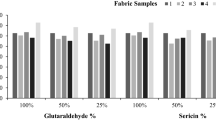Abstract
In this research, polyester fabrics were treated with three concentrations (10, 20 and 30 g/L) of macro- and microemulsions of silicones in water at 30 °C by the padding method. The treated fabrics were then dried/cured at 130 °C for 40 s. Some of the physical and chemical properties of the samples are discussed. The drapeability of treated samples was lower and found to depend on the silicone particle size. Moisture absorbency of treated samples was also lower. Colorimetric properties of softener treated fabrics were evaluated with a reflectance spectrophotometer. Scanning electron microscope (SEM) examinations showed an aggregation of silicone particles on the fiber surface.
Access this article
We’re sorry, something doesn't seem to be working properly.
Please try refreshing the page. If that doesn't work, please contact support so we can address the problem.


Similar content being viewed by others

References
Perkins WS (1996) Textile coloration and finishing. Carolina Academic Press, NC
Tomasino C (1992) Chemistry and technology of fabric preparation and finishing. North Carolina State University, NC
Wahle B, Falkowski J (2002) Softeners in textile processing. Part 1: an overview. Rev Prog Color 32:118–124
Habereder P, Bereck A (2002) Softeners in textile processing. Part 2: silicone softeners. Rev Prog Color 32:125–137
Nahta R (1981) Textile softeners. Am Dyest Rep 8:22–26
Venkataraman K (1972) The chemistry of synthetic dyes. Academic Press, London
Montazer M, Parvinzadeh M, Kiumarsi A (2004) Colorimetric properties of wool dyed with natural dyes after treatment with ammonia. Color Technol 120:161–166
Montazer M, Parvinzadeh M (2004) Effect of ammonia on madder-dyed natural protein fiber. J Applied Polym Sci 93:2704–2710
Montazer M, Parvinzadeh M (2007) Dyeing of wool with marigold and its properties. Fibers Polym 8:181–185
Parvinzadeh M (2007) The effects of softeners on the properties of sulfur-dyed cotton fibers. J Surfactants Deterg 10:219–223
Parvinzadeh M, Peyravi A (2005) Colorimetric properties of direct dyed cotton fabrics after treatment with softeners. In: 10th congress of international color association, Granada, Spain
Parvinzadeh M, Najafi H (2008) Textile softeners on cotton dyed with direct dyes: reflectance and fastness assessments. Tenside Surfactants Deterg 45:13–16
Warner ML, Joseph CS, Gerard AD, Robert MR (1958) Fabric treatment with cationic softeners. J Am Oil Chem Soc 35:590–593
Chiweshe A, Crews PC (2000) Influence of household fabric softeners and laundry enzymes on pilling and breaking strength. Text Chem Color Am Dyest Rep 32:41–47
Wilk KA, Poźniak R, Sokoŀowski A (2000) Antistatic and wetting properties of chemodegradable cationic surfactants containing 1, 3-dioxolane moiety. J Surfactants Deterg 3:207–211
Ackerman JA (1983) How to choose cationics for fabric softeners. J Am Oil Chem Soc 60:1166–1169
O’Lenick AJ Jr (2000) Silicone emulsions and surfactants. J Surfactants Deterg 3:387–393
Simpson BG (1958) The effect of silicone softeners on resin treated cottons. Text Res J 28:170–179
Jang KO, Yeh K (1993) Effects of silicone softeners and silane coupling agents on the performance properties of cotton fabrics. Text Res J 63:557–565
Moon SJ, Kang TJ (2000) Effects of epoxide and silicone polymers on the mechanical and performance properties of wool fabric. Text Res J 70:1063–1069
Tzanov TZ, Betcheva R, Hardalov I, Hes L (1998) Quality control of silicone softener application. Text Res J 68:749–755
Acknowledgments
We are grateful to Mr. Jahangiri and Zarine from Arman Chimi Afrooz Company, Tehran, Iran for providing the silicone softeners.
Author information
Authors and Affiliations
Corresponding author
About this article
Cite this article
Parvinzadeh, M., Hajiraissi, R. Macro- and Microemulsion Silicone Softeners on Polyester Fibers: Evaluation of Different Physical Properties. J Surfact Deterg 11, 269–273 (2008). https://doi.org/10.1007/s11743-008-1081-7
Received:
Revised:
Accepted:
Published:
Issue Date:
DOI: https://doi.org/10.1007/s11743-008-1081-7



